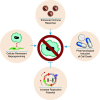Physiological and pathological consequences of cellular senescence
- PMID: 25080110
- PMCID: PMC4207941
- DOI: 10.1007/s00018-014-1691-3
Physiological and pathological consequences of cellular senescence
Abstract
Cellular senescence, a permanent state of cell cycle arrest accompanied by a complex phenotype, is an essential mechanism that limits tumorigenesis and tissue damage. In physiological conditions, senescent cells can be removed by the immune system, facilitating tumor suppression and wound healing. However, as we age, senescent cells accumulate in tissues, either because an aging immune system fails to remove them, the rate of senescent cell formation is elevated, or both. If senescent cells persist in tissues, they have the potential to paradoxically promote pathological conditions. Cellular senescence is associated with an enhanced pro-survival phenotype, which most likely promotes persistence of senescent cells in vivo. This phenotype may have evolved to favor facilitation of a short-term wound healing, followed by the elimination of senescent cells by the immune system. In this review, we provide a perspective on the triggers, mechanisms and physiological as well as pathological consequences of senescent cells.
Figures



References
-
- Hayflick L, Moorhead PS. The serial cultivation of human diploid cell strains. Exp Cell Res. 1961;25:585–621. - PubMed
-
- Allsopp RC, Harley CB. Evidence for a critical telomere length in senescent human fibroblasts. Exp Cell Res. 1995;219(1):130–136. - PubMed
-
- Harley CB, Futcher AB, Greider CW. Telomeres shorten during ageing of human fibroblasts. Nature. 1990;345(6274):458–460. - PubMed
-
- Allsopp RC. Models of initiation of replicative senescence by loss of telomeric DNA. Exp Gerontol. 1996;31(1–2):235–243. - PubMed
Publication types
MeSH terms
LinkOut - more resources
Full Text Sources
Other Literature Sources

